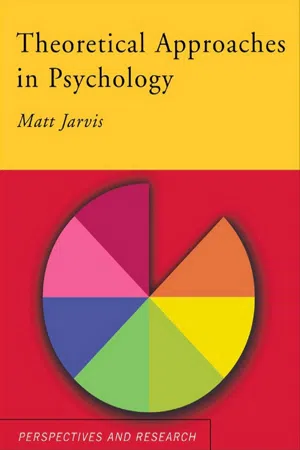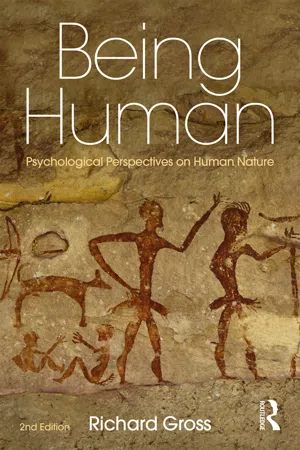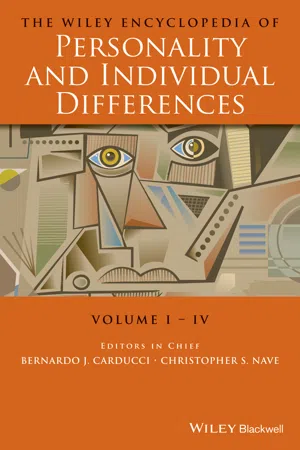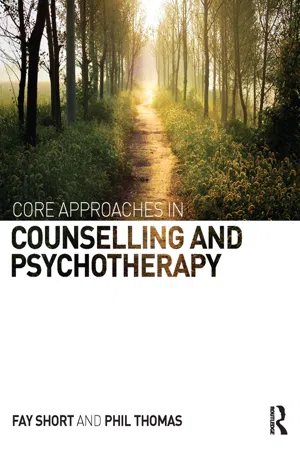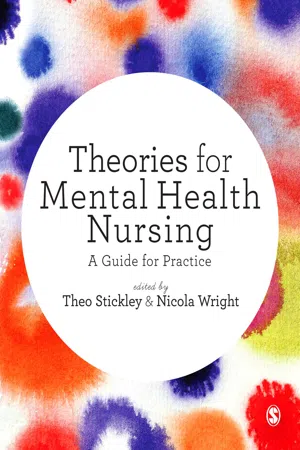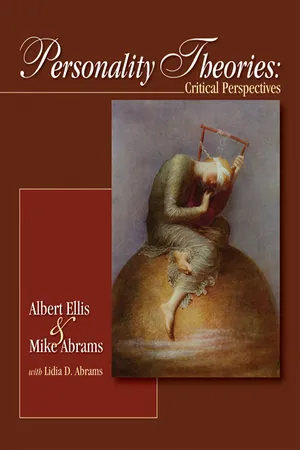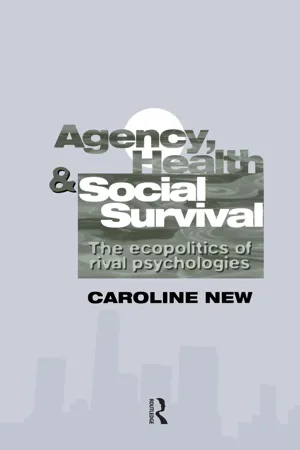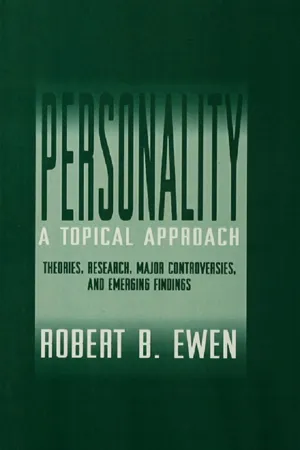Psychology
Humanistic Theory of Self
The Humanistic Theory of Self emphasizes the individual's capacity for personal growth, self-actualization, and fulfillment of potential. It focuses on the subjective experiences and perceptions of the self, emphasizing the importance of personal agency and self-awareness. This theory highlights the significance of human emotions, creativity, and the pursuit of meaning and purpose in life.
Written by Perlego with AI-assistance
Related key terms
Related key terms
1 of 4
Related key terms
1 of 3
12 Key excerpts on "Humanistic Theory of Self"
- eBook - ePub
- Matt Jarvis(Author)
- 2005(Publication Date)
- Routledge(Publisher)
- Humanistic psychology has given us a simple, accessible and effective model of counselling. This has meant that many more people have access to psychological help than would probably be the case otherwise.
- Perhaps most importantly, humanistic psychology is alone in the major psychological approaches in emphasising the positive aspects of human nature and adopting a thoroughly positive attitude to humanity.
Despite these contributions, it is almost certain that humanistic psychology will remain a subversive element in psychology rather than part of mainstream psychology. Some of the major limitations of a humanistic approach are as follows:- To an even greater extent than the psychodynamic approach, humanistic psychology has generated theories and ideas that have proved very difficult to test by scientific investigation.
- Because the subject matter of humanistic psychology is the experience of the individual person, there is a logical problem of applying theories generated from one individual to another. We cannot for example assume that two people experience the same thing when they speak of a peak or spiritual experience.
- Many humanistic ideas (particularly those around the development of the self) are extremely culture bound, and cannot easily be applied to a range of societies or historical periods.
- The humanistic emphasis on the individual person means that the importance of external influences on people’s lives have probably been underestimated. As Lerman (1992) has pointed out, a battered wife can learn through humanistic psychology that she has a right not to be abused, but it does not in itself allow her to leave the situation safely.
Summary
Humanistic psychology emerged through the work of Rogers and Maslow, who sought to create a third force in psychology to escape the restrictions of behavioural and psychodynamic psychology. They proposed a simple and optimistic psychology with a minimum of theory that would address what people described as important experiences. The major application of humanistic psychology is in counselling, where the experience of the individual is of paramount importance. Although the humanistic perspective remains important, it has limited influence in psychological research because of its untestable ideas and emphasis on the experiences of the individual. - eBook - ePub
Being Human
Psychological Perspectives on Human Nature
- Richard Gross(Author)
- 2019(Publication Date)
- Routledge(Publisher)
Figure 7.1 ), along with other humanistic psychologists (including Rogers, Fromm, and May) emphasised the ‘human’ characteristics of human beings. (It seems ‘obvious’ that psychology would be concerned with subjective experience!).The term ‘humanistic psychology’, first coined by John Cohen, a British psychologist (in a 1958 book with that title), aimed at condemning ‘ratomorphic robotic psychology’ (see Chapter 6 ). But it was primarily in the US, and especially through the writings of Maslow, that humanistic psychology became popularised and influential, hailing it as a ‘third force’ (the other two being behaviourism and psychoanalytic theory). Rather than rejecting these two major approaches, Maslow hoped that his approach would act as a unifying force , integrating subjective and objective, the private and public aspects of the person, providing a complete, holistic psychology. He insisted that a truly scientific psychology must embrace a humanistic perspective, treating its subject matter as fully human. What does ‘fully human’ mean?Major features of humanistic psychologyFigure 7.1Abraham Maslow (1908–70), humanistic psychologist. (Permission granted by Alamy.)1 Humanistic psychology acknowledges individuals as perceivers and interpreters of themselves and their world, trying to understand the world from the perceiver’s perspective, rather than from the position of a detached observer. This represents a phenomenological approach, which is described in Box 7.1.2 Humanistic psychology recognises that people help determine their own behaviour and aren’t simply slaves to environmental contingencies (as proposed by Skinner) or to their past (as proposed by Freud). Probably the most well-developed account of free will within humanistic psychology is that of Rogers (see Figure 7.2 ). If we want to understand another person, experience is all-important; in particular, we need to understand his/her self-concept - (Author)
- 2020(Publication Date)
- Wiley(Publisher)
Clinical Applications of Humanistic Theory of PersonalityStan Charnofsky and Cindy SayaniCalifornia State University, NorthridgeHumanism: The Third Force in Psychology
In 1956, Humanistic psychologist Carl Rogers and behaviorist B. F. Skinner engaged in a passionate debate (Rogers, 1989 ). This debate focused acutely on what precisely it means to be a human being. While Rogers emphasizes inner life, including will, choice, freedom, feelings, growth, courage, and self‐actualization, Skinner emphasizes outer life, observable behavior, reinforcement modes, and issues of shaping and control. Skinner argued that the “personality” and inner life are fictions that are often used to account for reality, and that reality is primarily external. People, Skinner noted, are confused that their behavior is based on their “will” or “innerness” while in fact the cause of behavior is a history of external reinforcement from the past, in which actions have been met by consequences that have shaped them. Rogers, on the other hand, expressed dismay at this view of human life, and noted that his reality was filled with individuals with rich inner lives. He stated that feelings are vital and one must recognize and attempt to understand and accept them through Humanistic therapy. He notes that we have an inner compass that guides our activities. His big criticism of Skinner is that his is a world with no freedom or meaning, and that people are more like robots and are only shaped by external reinforcers. In Skinner’s view, therefore, there is no room for creative behavior, which would deny the inner brilliance of a Beethoven, a Mozart, or a Picasso. For Skinner there is no possibility of a human being who is not shaped- eBook - ePub
- Fay Short, Phil Thomas(Authors)
- 2014(Publication Date)
- Routledge(Publisher)
Drive for reward, drive for food, sex drive, etc. are present in almost all species across the world Humanists in the 1950s began to explore elements of the human that are overlooked in other fields of psychology Essentially human phenomena such as love, hope, creativity, individuality, the nature of being, self-consciousness, self-awareness, philosophy, language, art and moralityFriedman (1994) argued that the humanistic shift could be described as a move ‘from determinism to self-determination, from causality to purpose, from manipulation to self-responsibility, from analysis to synthesis, from diagnosis to dialogue, from solution-oriented models to process, from degradation of human life to celebration of the human spirit’This approach rejects the objective control of science in favour of an empathic understanding of humanityMajor advances in the humanistic approach
Initial interest in humanistic approach
Rogers suggested that psychology in general and therapy in particular should focus on the individual as a unique human beingCounseling and Psychotherapy published in 1942Client-Centred Therapy published in 1951Maslow suggested that psychology should focus on exploring human behaviour in terms of our desire to satisfy needs and argued that theories of motivation should be human centred rather than animal centredA Theory of Human Motivation published in Psychological Review in 1943Motivation and Personality published in 1954Formal establishment of humanistic approach
Detroit meetings at the invitation of Maslow and Moustakas took place in 1957 and 1958 - eBook - ePub
Theories for Mental Health Nursing
A Guide for Practice
- Theo Stickley, Nicola Wright, Theo Stickley, Nicola Wright(Authors)
- 2013(Publication Date)
- SAGE Publications Ltd(Publisher)
You may view this actualising tendency as a pathway of maturity that leads and motivates us to reach our full potential physically, emotionally and spiritually. The person-centred philosophy places a high value on the uniqueness of each individual and hence fully acknowledges that we develop in different ways according to influences from our environment, culture and the construct of our personalities.So the underpinning assumption is that the person is the catalyst for his/her own healing. We are able to discover our own capabilities, have the power to heal ourselves and find solutions to our own problems. The potential is there, however there are many of life’s obstacles, hindrances and roadblocks in the way.From birth we are unable to escape everyday life experiences and interactions with others, so this natural tendency is subject to the many influences of life on life’s terms. Our growth and development for well-being can be distorted or overcome by our subjective reality and the demands of society, so our actualising tendency may become distorted. Central to understanding some of the distortions that take place we need to consider Rogers’ viewpoint on personality development, the meaning of self and self-concept.The self-conceptSelf-concept is the perception we have about our self and can also be described as an awareness of being (Rogers, 1980). The self-concept develops through interactions with others. Two primary sources that influence our self-concept are childhood experiences and evaluation by others. It is therefore formed from all the acquired learning and messages we receive from significant others and the outside world. To have a positive self-concept we need positive regard, which refers to the acceptance, approval and love by our significant others. Thorne (2011: 149) notes that ‘the need for positive regard or approval is overwhelming and is present from early infancy’. Dryden and Mytton (1999) add that as the child grows it becomes aware of the evaluations of others, which will be at times positive and other times, negative. We attach values to these childhood messages and interactions with others and often that will be whether we feel good or bad as a result of the experiences (Frankland and Sanders, 1995). For our own safety and security we need messages of what is right or wrong, safe or dangerous. So the development of the self-concept is heavily dependent on the values and attitudes of parents, parental figures and significant others in our lives. Some messages, however, can be distorted and cause conflict and anxiety with the core self and actualising tendency. The young boy who falls over and cries is maybe told to stop crying like a baby, when what he needed was a big hug; a young girl is maybe told off for being covered in paint, when she wanted praise for being creative. The child’s experiences, and evaluations, as he or she interacts with significant others will at times be positive – ‘well done’ – or negative – ‘stop doing that’. So during the child’s interactions with the environment and significant others he or she will start to build a picture of themselves. If these experiences are often negative the development and growth of the self-concept in adulthood can also be negative (Hough, 2002). Fortunately rejection and disapproval can be fleeting and we get over it. However difficulties can arise when it is more continuous and there is a conflict with what we truly believe about ourselves, and the conditions others place upon us of what we should and should not do. Patients in our care will often have a poor self-concept and hence poor self-esteem; they may have been judged frequently in their past, and their actualising tendency has been distorted as their own choices and decisions have been taken away from them. The positive or conditional regard we receive from others is significant in the development of the self-concept. - eBook - ePub
Ordinary Ecstasy
The Dialectics of Humanistic Psychology
- John Rowan(Author)
- 2015(Publication Date)
- Routledge(Publisher)
This brings out one of the thoughts which is very characteristic - people are all right as they are. Remember the transformation of quantity into quality referred to in the Introduction, and the paradoxical theory of change mentioned there. There is nothing extra which they need in order to be whole - all that is necessary is for them to take down the shutters and the blinkers, and let the sun shine in. As Rogers puts it:One of the most revolutionary concepts to grow out of our clinical experience is the growing recognition that the innermost core of man's nature, the deepest layers of his personality, the base of his 'animal nature', is positive in nature - is basically socialized, forward-moving, rational and realistic . . . We do not need to ask who will socialize him, for one of his own deepest needs is for affiliation and communication with others ... He is realistically able to control himself, and he is incorrigibly socialized in his desires. There is no beast in man. There is only man in man . . .(Rogers 1961, pp. 90-105)This outlook distinguishes humanistic psychology from the other two main streams in psychology today. Both behaviourism and psychoanalysis have a pessimistic, 'bad-animal' view of human nature, and therefore an exaggerated respect for the needs and powers of society to socialize and tame the child, and to keep the adult socialized and tamed. (Cognitive psychology in its own way betrays a lack of trust in the person, and is no better in this regard.) It is for this reason that humanistic psychology is sometimes called the Third Force. Rogers links with Maslow in that his theory of the person also holds that people tend naturally and of themselves to grow into fully functioning people, though they can hold themselves back from that in many different ways and for many different reasons. There is again one great force which drives through people and pushes them on, though they may resist or be prevented by others from going all the way.Children are prevented from developing normally by conditions of worth being applied to them. This means that they are not valued for themselves, but only for their ability to conform to the parental needs and wishes. They may then lose their internal locus of evaluation, and with it their ability to trust their own judgement. They have been given a negative self-image, and have lost touch with the real self. To act upon the negative self-image is to increase this separation. - eBook - ePub
The Handbook of Life-Span Development, Volume 2
Social and Emotional Development
- (Author)
- 2010(Publication Date)
- Wiley(Publisher)
The relationship between I and Me has received a good deal of scholarly and scientific attention in the humanistic tradition (e.g., Rogers, Maslow), cognitive-developmental studies, social and personality psychology, and recent narrative perspectives on self and identity. From Rousseau and Emerson to the latest writings in self-determination theory (e.g., Ryan & Deci, 2006), a strong humanistic streak runs through many Western conceptions of selfhood, emphasizing the inherent goodness, uniqueness, and integrity of an autonomous, inner-directed, and intrinsically motivated I—an I whose very reason for being is to realize its full potential. Cognitive-developmental perspectives chart the growth of the I (and the Me) from primitive, simple, and egocentrical childhood versions to the more complex, sociocentric, and principled forms encountered in adolescence and adulthood. By contrast, the field of social psychology has tended to ignore how the self changes and grows over time and has instead examined a range of self-processes, such as self-regulation, self-awareness, self-enhancement, and self-verification. The I imagined by contemporary social psychologists seems to see itself (the Me) as a broad compendium or digest of semantic information—selfschemas, self-aspects, possible selves, social identities, and so on—that may be called on to address a wide range of challenges in social life. Recently developed narrative theories of the self suggest that the compendium includes episodic information as well, such as autobiographical recollections and other stories of the Me, both remembered from the past and imagined for the future. From a narrative perspective, identity itself may be an internalized and evolving story that the I constructs about the Me to provide life with some semblance of unity, purpose, and meaning. The I is (in part) a storyteller, and the Me is (in part) the story that it tells.THE SELF AS ACTOR
Gathering together initial impressions regarding the behavior of human beings on earth, a visitor from another galaxy finds especially noteworthy the fact that these strange creatures always live in groups wherein they engage in complex and highly ritualized social action. At first, our other-worldly friend cannot do interviews with the objects of her study; she can but observe their behavior from an objective distance, like Locke’s punctual perspective from which the I gazes upon the Me. Yet there is so much to see! Human beings constantly interact with each other. They gather together in pairs and groups to discuss just about anything that can be discussed. They work in groups to accomplish difficult, multifaceted tasks. They congregate together to eat, play, learn, and pray. They pay an inordinate amount of attention to their youngest ones, providing care, instruction, and discipline. They cooperate with each other to stage complex social performances. However, they also compete for scarce resources in the environment, be those resources food, land, material possessions, mates, or prestige. They endlessly argue, negotiate, and bargain. There seems to be a tremendous amount of social conflict in and between their groups, which often leads to fighting. They organize themselves as armies to wage war. - eBook - ePub
Personality Theories
Critical Perspectives
- Albert Ellis, Mike Abrams, Lidia Dengelegi Abrams(Authors)
- 2008(Publication Date)
- SAGE Publications, Inc(Publisher)
Chapter 11Humanistic Views of Personality
Chapter Goals- Outline the development of the humanistic school in psychology
- Show how humanism came into being, in part as a response to the pessimistic concepts of psychoanalysis and the mechanistic methods of behaviorism
- Explain the importance and role of Abraham Maslow in the humanistic movement in psychology
- Trace the growth of the existential movement in psychology and detail its connection to humanism
- Explore both the strengths and weaknesses of humanistic psychology in explaining human personality
T he fact that we speak at all of a humanistic approach to psychology leads to an obvious question: Why did some psychologists feel this approach was necessary? After all, to propose a humanistic approach to psychology implies that psychology in its essence is not concerned with human beings. In fact, this was precisely the point the early humanist psychologists were making.By the middle of the 20th century, psychiatry was dominated by psychoanalytic views of personality as well as of mental pathology. The leading school of thought in the field of psychology itself was behaviorism, which was taught and practiced in most universities and clinical centers, especially in the United States. A majority of psychologists approached all organisms, including humans, in terms of their responses to stimuli. Such internal events as thoughts and emotions were considered to be irrelevant to psychology. They could neither be observed nor directly tested; thus, including them in analyses of human nature was considered unscientific. This restriction led some psychologists to find the dominant view far too limiting. They maintained that behaviorism had eliminated some of the most important dimensions of the human psyche. This point of view had been indirectly supported in an earlier generation by such psychologists as Max Wertheimer, Kurt Koffka, and Wolfgang Köhler. These theorists are generally credited with developing the Gestalt (from the German word for form or shape - eBook - ePub
Agency, Health And Social Survival
The Ecopolitics Of Rival Psychologies
- Caroline New(Author)
- 2015(Publication Date)
- Routledge(Publisher)
Chapter 7 Humanistic psychology: Saved by synergyIntroduction
We turn now to humanistic psychology, which embraces independence of social conventions as part of its notion of mental health. Humanistic psychology is as diverse as psychoanalysis. It is united only by the principle that the true, original self is naturally social and cooperative and that both inner conflict and social evil are environmentally produced. There is not such a gulf between psychoanalysis and humanistic psychology as my selection of theorists might suggest. Ego psychology's 'conflict-free zone' of the ego begins to bridge the gap. Horney, Fromm, Sullivan and the 'culture school' identify patterns of defence as typical of entire societies and as products of their culture (e.g. Sullivan, 1964, p. 70). Reich (1968) believes that genitally healthy people, capable of surrendering themselves in genuine orgasm, would be socially cooperative, non-authoritarian and self-regulating. The mismatch between society and our real, genital selves is merely 'the artifact of a sex-negating culture' (Reich, 1968, p. 232). And as we have seen, for object-relations theorists such as Fairbairn, Guntrip, Winnicott, Kohut and Kernberg the individual's internal world is significantly affected by the environment, as 'formed in the cataclysmic encounters of childhood and perpetuated in the depths of the unconscious' (Frosch, 1987, p. 94). Social relations are key to the construction of the self. Aggression tends to be reactive and the drives operate in the service of a relationship-seeking ego. If the social environment allows the child's needs to be met (including its need for love), theoretically internal splitting can be avoided.The theories so briefly mentioned here form a philosophical bridge between psychoanalytic and humanistic theories. For this very reason, the conflicting principles involved in this area are more clearly extracted from the theories on either side of the stream. From the psychoanalytic side, object-relations theories are frequently accused of having gone over to humanism, to the territory of the 'true self' and the 'whole ego' (Frosch, 1987, p. 107). We have seen how contemptuous Lacan was of ego-psychology, of its faith in the ego's susceptibility to reason. For him, too, American ego-psychology and humanistic psychology were both revisionist idiocies which elevated that illusion: the conscious self as rational actor. In order to assess these criticisms we must now cross the water to the territory of the 'human potential movement'. - eBook - ePub
Personality: A Topical Approach
Theories, Research, Major Controversies, and Emerging Findings
- Robert B. Ewen(Author)
- 2013(Publication Date)
- Psychology Press(Publisher)
Both theory and research are essential to the study of personality. Theories help us to bring order out of chaos by organizing substantial amounts of information, focusing attention on those matters that are or greater importance, and offering explanations for the phenomena being studied. Research enables us to test predictions derived from the theory so that it may be evaluated and improved (or discarded). In the absence of research, theory remains subjective, and we have only the theorists’ beliefs to support their ideas. In the absence of theory, research produces myriad fragments of information that are difficult to assemble and comprehend, as well as numerous similar constructs that often represent a distinction without a difference.The evidence presented in this chapter indicates that the self is a construct of considerable importance, and that maintaining self-esteem is a fundamental human need. However, the self is only part of the story. To best understand the human personality, the work of self theorists must be integrated with the findings of the other major approaches that we have discussed in this book.PostscriptSelf-confidence is the first requisite to great undertakings.—Samuel Johnson Summary1. Although Maslow shared Rogers’ optimistic view of human nature, Maslow cautioned that our innate positive tendencies are very weak and are easily overwhelmed by the more powerful forces of learning and culture. Deficiency motives aim toward the reduction of such drives as hunger, thirst, and obtaining love and esteem from others. Growth motives are relatively independent of the environment and include pleasurable drive increases (such as curiosity), the unselfish giving of love to others, and developing one’s own inner potentials.2. Maslow contended that human needs differ considerably in importance, with some needs remaining virtually unnoticed until others have at least to some extent been satisfied. His hierarchical model includes five levels of human needs: physiological (lowest), safety, belongingness and love, esteem, and self-actualization (highest). Research concerning the hierarchy of human needs has yielded equivocal results, and there is as yet insufficient evidence to support the widespread applicability of Maslow’s model. - eBook - ePub
- Paul Wilkins(Author)
- 2002(Publication Date)
- SAGE Publications Ltd(Publisher)
5
Self-Actualisation: A Culture-Bound, Naive and Optimistic View of Human Nature?
There are many critics of what is assumed to be the naive optimism of person-centred practitioners. Quinn (1993: 21) considers that:By choosing to place an absolute and unwavering faith in the efficacy of two ultimately unprovable human dimensions (the actualising tendency and organismic valuing process), tthe person-centred approach! opens itself to charges of Pollyannish optimism and therapeutic passivity.Similarly, van Deurzen-Smith (1988: 56) criticises the assumption in humanistic psychology (and by implication person-centred therapy) that human beings are ‘basically positive creatures who develop constructively, given the right conditions’, and Yalom (1980: 19) questions the ‘almost exclusive’ emphasis on individual freedom, choice and liberation he sees as inherent to humanistic approaches. Central to this criticism is the person-centred belief that people are positively driven towards constructive growth by the actualising tendency and (mistakenly) that there is, in person-centred philosophy, an ideal endpoint to growth, the state of self-actualisation or being ‘fully functioning’. This is seen as unrealistic – there is so much evidence of man’s inhumanity to man that belief in the progressive nature of people is almost delusional! And so many people are manifestly not operating optimally that the belief we can do so must be mistaken. As long ago as 1959, Rogers (in Kirschenbaum and Henderson, 1990b: 27) was aware of this, but refuted the criticism:The emphasis on the self-directive capacity of the individual and the release of this potential through a suitable growth-promoting climate have for some reason stirred much criticism. Some have thought of the client-centered therapist as an optimist. Others have felt that this line of thought follows Rousseau. Neither criticism seems to me to be true. The hypothesis In regard to the capacity of the individual is, rather, distilled out of an accumulated experience with many mildly - eBook - ePub
- Michele Baldwin, Michele Baldwin(Authors)
- 2013(Publication Date)
- Routledge(Publisher)
4 Some Philosophical and Psychological Contributions to the Use of Self in TherapyDeWitt C. Baldwin Jr.IntroductionIt is always interesting to speculate why certain ideas emerge at a particular time. It is especially intriguing to review the reasons why attention should be called at this time to the use of self* in therapy. According to systems theory, therapists are unavoidably part of the treatment situation, both as therapists (change agents) and as themselves. They do not choose to be in or out, they can only choose to be aware or not. That this role can operate along a continuum from activity to passivity has been alluded to by a number of authors (Hollender and Szasz, 1956). Indeed, a major development of the past several decades has been the increasingly active and participatory role in such transactions accorded to the patient. In this particular evolution, the seminal work of Carl Rogers must be noted, in that he saw the potential for self-direction in patients, whom he began to refer to as clients, viewing the therapist as assisting rather than promoting the process of self-determination and development.It is not surprising that the movement toward a more humanistic psychology which emerged after World War II was accepted by many therapists, who found the determinism and reductionism of the Freudian view unsatisfactory from a personal and professional standpoint. This resulted in an outpouring of interest in the uniqueness and authenticity of human experience. Belief in the self-actualizing ability of people led to the formation of the human potential movement of the 1960s and 1970s (Maslow, 1962). Unfortunately, proponents of this movement often carried the idea of personal growth to the limits of personal license and failed to develop a disciplined and systematic examination of its assumptions and implications. Each person's experience was considered valid in itself and, in the place of the rigidities of traditional psychiatry and psychology, there emerged a plethora of therapeutic systems and approaches, based on individual style, inclination, and popularity. Indeed, the field of therapy appeared to move from an excessive dependence upon rigid theories and formats to an equally excessive emphasis on idiosyncratic techniques and therapeutic stratagems, that, often as not, were more artificial and manipulative than the traditional approaches.
Index pages curate the most relevant extracts from our library of academic textbooks. They’ve been created using an in-house natural language model (NLM), each adding context and meaning to key research topics.
Explore more topic indexes
Explore more topic indexes
1 of 6
Explore more topic indexes
1 of 4
